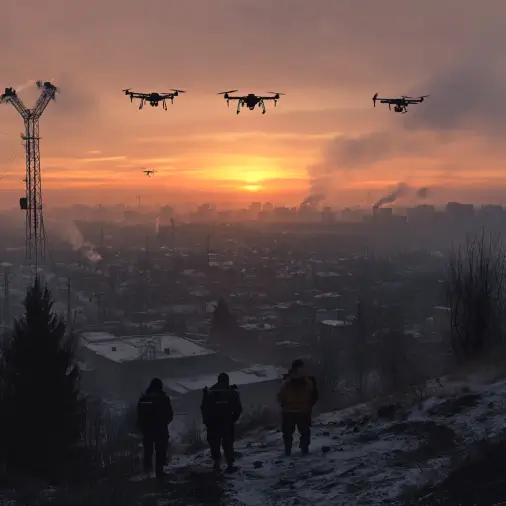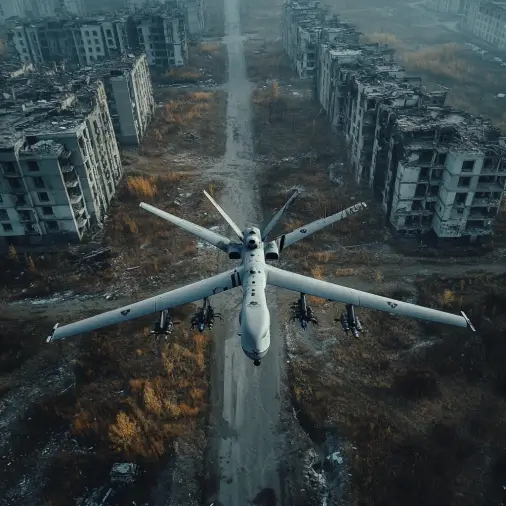In the annals of modern military history, few events have had as significant an impact on the future of warfare as Ukraine’s innovative use of drones. As the conflict between Ukraine and Russia continues to unfold, the integration of drone technology into Ukraine’s military strategy has not only provided a tactical advantage but also revolutionized how wars are fought in the 21st century. This blog post delves into the multifaceted ways Ukraine has harnessed drone technology, offering a blueprint for future military engagements worldwide.
The Emergence of Drones as a Critical Military Asset
The use of drones in warfare is not new, but Ukraine’s application of this technology is unprecedented in its scale and effectiveness. Drones, also known as Unmanned Aerial Vehicles (UAVs), have become indispensable in Ukraine’s defense strategy. From surveillance and reconnaissance to direct strikes and electronic warfare, drones have allowed Ukraine to maintain a degree of parity against a more heavily armed adversary.

The Tactical Advantage of Drones in Modern Warfare
Ukraine’s drone program is remarkable not just for its scope but for the tactical advantages it has conferred. For instance, drones provide real-time intelligence, allowing commanders to make informed decisions rapidly. The ability to gather high-resolution imagery and video from the battlefield gives Ukraine the upper hand in terms of situational awareness. This intelligence is not only used for defensive purposes but also for planning and executing offensive operations.
Moreover, the mobility and flexibility of drones enable Ukraine to perform operations that would be otherwise impossible or highly risky with manned aircraft. For example, drones have been used to infiltrate enemy lines, deliver precise strikes on high-value targets, and even disrupt supply chains. This capacity to carry out operations remotely has minimized casualties among Ukrainian forces while maximizing damage to the enemy.
Swarming Tactics: A New Era in Drone Warfare
One of the most innovative tactics employed by Ukraine is the use of drone swarms. Unlike traditional drone operations, which typically involve a single UAV or a small group, swarming involves deploying dozens or even hundreds of drones simultaneously. These swarms can overwhelm enemy defences, creating confusion and panic while executing complex maneuvers that would be impossible with manned systems.

Drone swarms have been particularly effective in taking out heavily fortified positions and armored vehicles. By attacking from multiple directions simultaneously, swarming drones can exploit weaknesses in enemy defenses that might not be vulnerable to conventional attacks. This tactic represents a significant evolution in military strategy, demonstrating how a technologically inferior force can neutralize a more powerful adversary using ingenuity and cutting-edge technology.
Custom Drones: Tailoring Technology to Battlefield Needs
Ukraine’s approach to drone warfare goes beyond simply deploying commercially available drones. The country has invested in developing custom drones tailored to specific military needs. These bespoke UAVs are equipped with advanced sensors, electronic warfare capabilities, and weapons systems, making them highly versatile tools on the battlefield.
For example, Ukraine has developed drones designed for electronic warfare, capable of jamming enemy communications and radar systems. These drones play a critical role in blinding and confusing Russian forces, allowing Ukrainian troops to operate with greater freedom. Additionally, Ukraine has integrated drones with its artillery and missile systems, enabling precise targeting and reducing the risk of collateral damage.
The adaptability of these custom drones has been a game-changer in the conflict. Ukraine’s ability to quickly modify and deploy drones based on real-time battlefield needs has kept the Russian military on its heels, constantly adapting to new threats.
The Broader Implications for Global Military Strategy
Ukraine’s success with drones has not gone unnoticed by the global military community. Nations worldwide are closely studying Ukraine’s tactics, recognizing that drones are no longer just auxiliary tools but central to modern military strategy. This realization is driving a new arms race focused on developing more advanced drones and counter-drone technologies.
Counter-Drone Technologies: The Next Frontier
As drones become more prevalent in warfare, so too does the need for effective counter-drone technologies. Ukraine’s success has prompted other nations to invest in systems designed to detect, track, and neutralize drones. These systems range from electronic jamming devices that disrupt drone communications to directed energy weapons that can physically destroy UAVs in flight.
The development of counter-drone technologies is critical for maintaining battlefield superiority. As drones become more sophisticated, the ability to counter them will become increasingly important. Countries that fail to develop or acquire these technologies risk being at a significant disadvantage in future conflicts.
The Impact on Military Doctrine and Strategy
The widespread use of drones by Ukraine has also influenced military doctrine and strategy. Traditional concepts of air superiority and battlefield dominance are being re-evaluated in light of the effectiveness of UAVs. Drones allow smaller, less resource-rich nations to challenge larger, more established military powers, leveling the playing field in a way that was previously unimaginable.
This shift in military strategy has implications for global security. As more countries adopt drone technology, the nature of warfare will continue to evolve. Future conflicts may see an even greater reliance on UAVs, with human soldiers playing a more limited role. This trend could lead to a decrease in casualties, but it also raises ethical and legal questions about the use of autonomous systems in warfare.
The Economic and Technological Ripple Effect
Ukraine’s use of drones is not just a military phenomenon; it has also had significant economic and technological repercussions. The demand for drones and related technologies has surged, leading to increased investment in research and development. This trend is creating new opportunities for businesses and entrepreneurs in the defense sector.
The Rise of the Drone Industry
The drone industry has seen explosive growth as a result of Ukraine’s success. Companies that develop and manufacture drones are experiencing increased demand from governments and militaries around the world. This growth is not limited to military drones; commercial UAVs used for logistics, agriculture, and surveillance are also seeing a boom.
In response to this demand, many countries are investing in domestic drone production capabilities. This investment is not only about meeting military needs but also about securing a share of the rapidly growing global drone market. Nations that can produce advanced drones domestically will be better positioned to influence the future of drone warfare.
Technological Innovations Driven by Military Needs
Military conflicts have historically driven technological innovation, and the Ukraine-Russia conflict is no exception. The need for more advanced, reliable, and versatile drones has accelerated the development of new technologies. These innovations include improvements in artificial intelligence, battery life, and materials science, all of which have applications beyond the military.
For instance, advances in AI are enabling drones to operate more autonomously, reducing the need for human operators and increasing the efficiency of drone operations. Similarly, improvements in battery technology are extending the range and endurance of UAVs, making them more effective in sustained operations.
The Ethical and Legal Challenges of Drone Warfare
As drones become more central to warfare, they also raise a host of ethical and legal challenges. The use of drones for targeted killings, surveillance, and electronic warfare poses questions about accountability, civilian casualties, and the rules of engagement.
The Debate Over Autonomous Weapons
One of the most contentious issues in drone warfare is the potential use of fully autonomous weapons. While current drones are typically operated remotely by human pilots, advancements in AI could lead to the development of drones capable of making decisions without human intervention. This prospect has sparked a global debate over the ethics of autonomous weapons and their potential to cause unintended harm.
Many experts argue that fully autonomous weapons should be banned under international law, as they could lead to uncontrollable escalations in conflict and increase the risk of civilian casualties. Others contend that autonomous systems could reduce the likelihood of human error and make military operations more precise and humane.
Legal Frameworks for Drone Warfare
The use of drones in warfare also raises legal questions, particularly regarding the application of international humanitarian law. Drones have been used to carry out targeted killings, often outside of declared war zones, leading to concerns about extrajudicial killings and violations of sovereignty.
International organizations and legal scholars are calling for clearer legal frameworks to govern the use of drones in warfare. These frameworks would need to address issues such as the distinction between combatants and non-combatants, the proportionality of drone strikes, and the accountability of drone operators.
Conclusion: The Future of Warfare is Here
Ukraine’s pioneering use of drones has not only transformed its own military strategy but has also set the stage for the future of warfare. As drones become more advanced and integrated into military operations, their role will continue to grow, influencing everything from battlefield tactics to global security policies.
The lessons learned from Ukraine’s use of drones will shape the strategies of nations for decades to come. Whether through swarming tactics, custom-built UAVs, or the integration of drones with other military systems, the future of warfare is being defined by the innovations seen on the battlefields of Ukraine.




